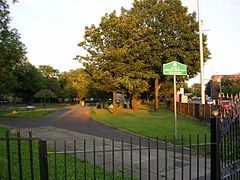Ardwick
| Ardwick | |
|---|---|
 Ardwick Green Park |
|
| Ardwick shown within Greater Manchester | |
| Population | 19,250 (2011 CensusWard) |
| OS grid reference | SJ856975 |
| Metropolitan borough | |
| Metropolitan county | |
| Region | |
| Country | England |
| Sovereign state | United Kingdom |
| Post town | MANCHESTER |
| Postcode district | M12 M13 |
| Dialling code | 0161 |
| Police | Greater Manchester |
| Fire | Greater Manchester |
| Ambulance | North West |
| EU Parliament | North West England |
Ardwick is a district of Manchester in North West England, one mile south east of the city centre. The population of the Ardwick Ward was at the 2011 census 19,250.
Historically in Lancashire, by the mid-19th century Ardwick had grown from being a village into a pleasant and wealthy suburb of Manchester, but by the end of that century it had become heavily industrialised. When its industries later fell into decline then so did Ardwick itself, becoming one of the city's most deprived areas. Substantial development has taken place more recently in Ardwick and other areas of Manchester to reverse the decline, notably the construction of many facilities for the 2002 Commonwealth Games held nearby in Eastlands.
In the late 19th century Ardwick had many places of entertainment, but the only remnant of that history today is the Art Deco Manchester Apollo, a venue for pop and rock music concerts.
Prior to the Industrial Revolution, Ardwick was a small village situated just outside Manchester in open countryside. The principal residents were the Birch family, one of whom was a major general when Oliver Cromwell (briefly) instituted direct military rule.
One Samuel Birch was instrumental in providing a small chapel of ease, dedicated to St. Thomas, and consecrated in 1741. This soon expanded into a Georgian church, to which a brick campanile tower was added in the 1830s. It contained a very rare Samuel Green organ, the first in which the sharp keys were distinguished in black. There was also a memorial chapel to the dead of the First World War, chiefly men of the local territorial unit. These have been removed, and the church is now used as offices for voluntary organisations.
...
Wikipedia

